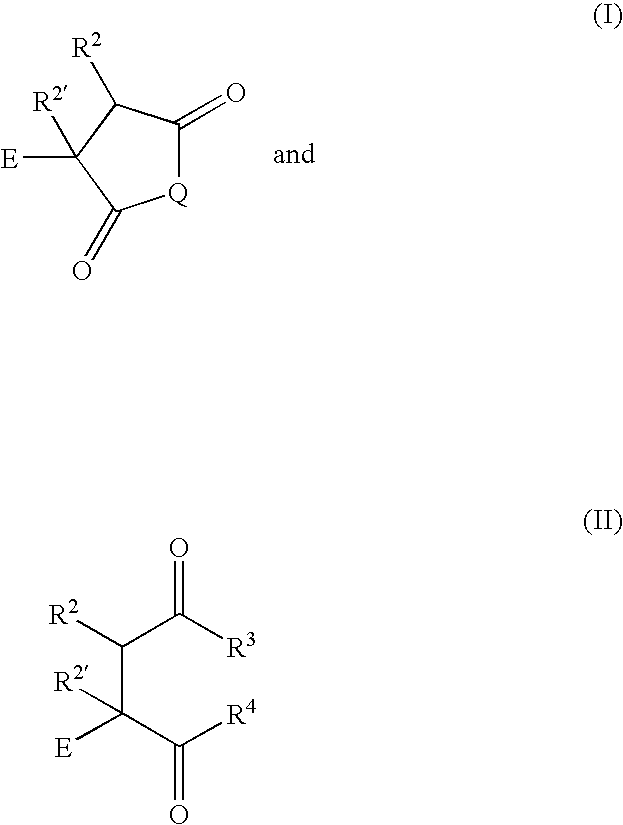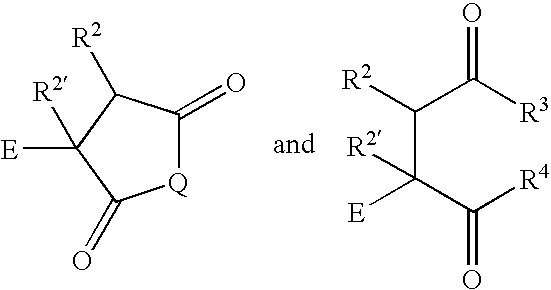Functionalized elastomer nanocomposite
a technology of functionalized elastomers and nanocomposites, which is applied in the field of nanocomposites, can solve the problems of unproven suitability of functionalized polymers for nanocomposites, limited application to materials soluble in water, etc., and achieve the effect of improving air barrier properties
- Summary
- Abstract
- Description
- Claims
- Application Information
AI Technical Summary
Benefits of technology
Problems solved by technology
Method used
Image
Examples
example 18
[0109] Example 18 illustrates the sequential addition of functionalizing agent and peroxide. For example 18, the following procedure was carried out: Butyl rubber (45 g, XP 50, 11.5% PMS) was melt blended in Brabender for one minute with a rotor speed of 60 rpm at 180° C. Then a solution of maleic anhydride (1.5 grams) and LUPEROX P (1 mL) in 3 mL acetone was added. After 8 minutes, more maleic anhydride (1.5 grams) and LUPEROX P (1 mL) in 3 mL acetone was added. After 8 minutes, the temperature was increased to 210° C. and mixing continued for 3 minutes. The mixture was then cooled down to 160° C.; 3 grams of modified polymer was removed. To the remaining modified butyl rubber, Cloisite 6A (4.5 g) was slowly added. After the addition, the mixture was mixed for 10 more minutes at 60 rpm and 160° C. The results of oxygen permeability are shown in Table 2.
example 19
[0110] Example 19 illustrates the use of functionalized butyl for blend application. For example 19, the following procedure was carried out: Butyl rubber (XP50, 31.5 grams) and maleic anhydride-modified XP50 (9.0 grams, succinic anhydride weight % in final polymer=0.9) were melt blended in a Brabender for three minutes with a rotor speed of 60 rpm at 160° C. To this melt was added Cloisite 6A (4.5 grams). The mixture was further mixed for 10 minutes. The results of oxygen permeability are shown in Table 2.
example 20
[0111] Example 20 illustrates the use of maleimide as functionalizing compound. For example 20, the following procedure was carried out: Butyl rubber (45 g, XP 50, 11.5% PMS) was melt blended in Brabender for one minute with a rotor speed of 60 rpm. A mixture of LUPEROX 11M75 (1.86 mL) and maleimide (2.97 grams) were slowly added and mixed for 5 minutes at 40° C. The blend was mixed in for 5 minutes with a rotor speed of 60 rpm at 200° C. Modified butyl rubber (40.5 g) was melt blended in Brabender for one minute with a rotor speed of 60 rpm and 160° C. Then, Cloisite 6A (4.5 g) was slowly added, and after the addition the mixture was mixed for 10 more minutes at 60 rpm and 160° C. The results of oxygen permeability are shown in Table 2.
PUM
| Property | Measurement | Unit |
|---|---|---|
| Volume | aaaaa | aaaaa |
| Volume | aaaaa | aaaaa |
| Volume | aaaaa | aaaaa |
Abstract
Description
Claims
Application Information
 Login to View More
Login to View More - R&D
- Intellectual Property
- Life Sciences
- Materials
- Tech Scout
- Unparalleled Data Quality
- Higher Quality Content
- 60% Fewer Hallucinations
Browse by: Latest US Patents, China's latest patents, Technical Efficacy Thesaurus, Application Domain, Technology Topic, Popular Technical Reports.
© 2025 PatSnap. All rights reserved.Legal|Privacy policy|Modern Slavery Act Transparency Statement|Sitemap|About US| Contact US: help@patsnap.com



